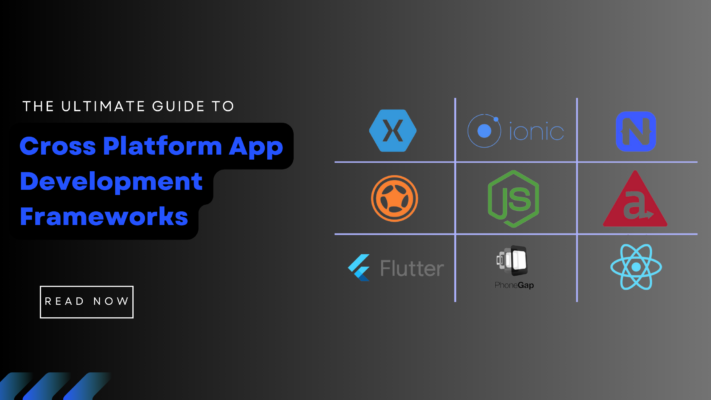
- January 20 2021
- admin
In 2024, Cross Platform App Development Frameworks are more popular than ever for building mobile and desktop apps. With so many options available, it can be difficult to determine which framework is the best fit for your project. This ultimate guide examines the top Cross Platform App Development Frameworks in 2024 and what makes each one unique. We’ll cover the benefits and drawbacks of each framework, best use cases, and tips for getting started. Read on to find the perfect Cross Platform App Development Framework for your next app!
What are Cross Platform App Development Frameworks?
Cross Platform App Development Frameworks allow developers to build mobile and desktop apps that work across multiple platforms including iOS, Android, Windows, macOS, and Linux using a single codebase. Rather than building native apps separately for each platform, Cross Platform App Development Frameworks provide tools and libraries that abstract away platform differences. This allows developers to reuse as much code as possible, reducing development time and costs compared to building platform-specific native apps.
Some of the most popular Cross cross-platform app Development Frameworks include React Native, Flutter, Xamarin, Ionic, and Qt. Let’s take a deeper look at each of these frameworks.
React Native
React Native is one of the most popular Cross Platform App Development Frameworks in 2024. It was created by Facebook and allows developers to build mobile apps using React, the same JavaScript framework used for web development. Apps are built using real native UI components, so they look and feel like any other app built natively for iOS or Android.
Here are some key features of React Native:
– Uses JavaScript and React, allowing web developers to easily transfer skills to build mobile apps
– Large open-source community with constant updates and improvements
– Hot reloading to view changes instantly during development
– Integration with native APIs like camera, location, etc.
– Broad ecosystem of packages to add functionality
– Backed by Facebook, already used in major apps like Instagram, Tesla, Skype
React Native is a great choice for developers who want to build cross-platform mobile apps using their existing web development skills. The large community also makes it easy to find solutions to common issues. If you need high-performance mobile apps that feel native, React Native is a top choice in 2024.
Flutter
Flutter is another popular Cross Platform App Development Framework created by Google in 2017. It uses the Dart programming language and provides its own widget set allowing developers to build native-feeling apps for iOS, Android, and more from a single codebase.
Here are some of Flutter’s notable features:
– Uses Dart language optimized for UI development
– Fast performance with a native compiler
– Expressive and flexible UI with a composable widget set
– Hot Reload for quick iteration during development
– Open source with growing community support
– Suitable for mobile, desktop, web, and embedded apps
Flutter is a great choice for developers who want a modern reactive framework value speed and high-quality UI. The widget set makes it easy to build consistent interfaces across platforms. And Dart is easy to learn for any developer with object-oriented language experience.
Xamarin
Xamarin is a Cross Platform App Development Framework from Microsoft that allows developers to use C# to build native iOS, Android, Windows, and macOS apps. Key features include:
– Uses C# codebase for cross-platform UI and business logic
– Compiles down to fully native performance on each platform
– Extensive library support including native APIs
– Sophisticated memory management and debugging
– Visual Studio integration and enterprise developer support
Xamarin is a top choice for C# developers who want to use their existing skills and tools to build cross-platform apps. It has extensive enterprise support from Microsoft and is suitable for large development teams. The apps also compile down to fully native performance.
Ionic
Ionic is an open-source framework focused on building highly interactive cross-platform mobile and desktop apps using web technologies like HTML, CSS, and JavaScript. Here are some key highlights:
– Builds as a Progressive Web App with an adaptable layout
– Angular-based framework with advanced components and tools
– Uses Cordova for native device access
– Single codebase that runs on iOS, Android, and desktop browsers
– Focus on highly interactive and smooth UI
– Extensive theming and design options
Ionic is ideal for web developers who want to build cross-platform apps with a responsive and app-like feel. Web technologies make it easy to create highly interactive UIs. Apps can be deployed as Progressive Web Apps or Cordova wraps for native deployment.
Qt
Qt is a C++ framework for creating cross-platform apps that target mobile, desktop, and embedded systems.
Here are some of its capabilities:
– Supports C++ with optional JavaScript for UI
– High-performance apps with small executable sizes
– Native look and feel on each target platform
– Integrated GUI editor and designer
– Animation and multimedia support
– Libraries for connectivity, localization, and more
– LGPL open source and commercial licensing
Qt makes it easy to develop cross-platform apps with native UIs in C++. It’s a great choice for performance-focused apps in fields like gaming and multimedia. Commercial licensing also provides support options for larger development teams.
Honorable Mentions
Here are a few other Cross Platform App Development Frameworks worth checking out:
NativeScript – Build truly native iOS and Android apps with JavaScript and CSS using Vue.js or Angular
Apache Cordova – Wrap HTML/JavaScript code into native apps for iOS, Android, and more
Electron – Use JavaScript/HTML/CSS to build cross-platform desktop apps
Unity – Game development framework with cross-platform support
Codename One – Write Java apps for multiple mobile OSes with a cross-platform UI toolkit
This covers some of the most popular options, but new Cross Platform App Development Frameworks continue to emerge offering different languages, tools, and capabilities. Always consider your target platforms, performance needs, and developer skills when evaluating frameworks.
Key Benefits of Cross-Platform App Development Frameworks
Now that we’ve covered some of the top Cross Platform App Development Frameworks, let’s discuss some of the benefits they offer:
Faster Development
With a Cross Platform App Development Framework, you can develop apps for multiple platforms simultaneously. The reusable codebase means much less time spent writing platform-specific code. Changes only need to be made once to update apps across all platforms.
Lower Cost
The ability to reuse code instead of reimplementing native apps for each platform translates to lower development costs. Maintaining one codebase is cheaper than separate codebases. Some frameworks are also open-source and free to use.
Smaller Teams
With code reuse, smaller teams can build and maintain the apps across platforms. For larger companies, individual platform teams are no longer needed, reducing labor costs.
Code Consistency
Business logic and core app code are shared across platforms, ensuring consistency in how the apps function. A change made to the shared codebase will be reflected on all target platforms.
Faster Time to Market
Getting an app to users quickly is crucial, especially for startups and smaller companies trying to gain traction. Cross Platform App Development Frameworks speed up the development process, allowing companies to launch simultaneously on multiple platforms.
Easier Maintenance
Updating and maintaining one codebase is simpler compared to managing separate codebases for different platforms. Developers only need to learn one language and framework.
When to Avoid Cross-Platform App Development Frameworks
While Cross Platform App Development Frameworks offer many benefits, they aren’t the ideal approach in all situations:
– If an app needs maximum performance optimization for a specific device or platform, native development is better.
– For apps with complex platform-specific requirements like 3D gaming or hardware integration, native code is preferred.
– When user experience depends heavily on adhering to strict platform interface guidelines, native tools are best.
– If specialized device capabilities like augmented reality are needed, it’s often easier with native APIs.
– When targeting a single platform, native development avoids unnecessary overhead.
The tradeoff is mainly between code reuse and performance. For many apps, Cross Platform App Development Frameworks provide good enough performance while maximizing productivity. But for certain use cases, native development is still the best option.
Tips for Getting Started with a Cross-Platform App Development Framework
If you’re sold on using a Cross Platform App Development Framework for your next project, here are some tips to hit the ground running:
Pick Your Core Platforms
Decide upfront which target platforms are essential, such as iOS and Android. Ensure any framework under consideration supports those platforms.
Consider Developer Skills
Evaluate developer experience with languages and frameworks. Leverage existing knowledge to maximize productivity.
Prototype Early
Build a simple prototype first to test technology choices. Switching later can be time-consuming and expensive.
Stick to Framework Guidelines
Follow best practices for the framework to avoid performance issues or rejected app store submissions.
Handle Platform Differences
Have plans for handling localized resources, database access, and any platform-specific APIs.
Conclusion
This guide covered the landscape of Cross Platform App Development Frameworks in 2024 from React Native to Flutter and Xamarin. We discussed the benefits of cross-platform development, top use cases, and tips for evaluating options. There are many great frameworks available depending on your needs and developer skills.
Cross Platform App Development Frameworks allow smaller teams to build mobile and desktop apps faster and cheaper by reusing code across iOS, Android, and more. But be aware of the tradeoffs compared to fully native development. For many applications though, these frameworks provide good enough performance while maximizing productivity.
If you’re considering Cross Platform App Development for your next project, this guide provides a comprehensive overview of popular options available in 2024. Be sure to assess your target platforms, performance requirements, and team capabilities. With the right framework choice, you can build high-quality cross-platform apps to delight users, no matter their device.
To learn more about app development and our capabilities, visit UpCore Technologies


